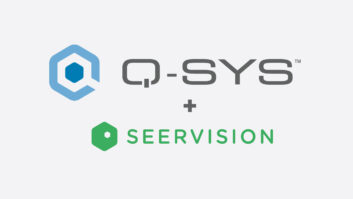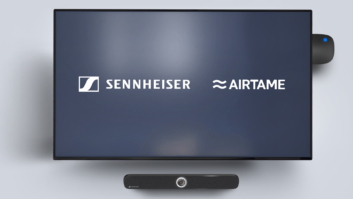
While simplicity, ease of use and – for some businesses – one-system standardisation are key to VC decision making, a number of emerging technologies are coming on stream that are set to complicate the decision-making process, even as they enhance the conferencing experience. “We are already seeing AI technology play an important role in videoconferencing, with features such as auto-crop and focus helping to make the conferencing experience as effective as possible,” explains Logitech’s Anne-Marie Ginn.
“For example, Logitech RightSight technology can automatically move the camera lens and adjust the zoom to frame meeting participants based on the size and shape of the room they are in, eliminating complicated remote controls and ensuring everyone can be clearly seen and heard.
“In the future, we are likely to see an even greater use of artificial intelligence, perhaps in the form of automating tasks such as rescheduling calls and rebooking meeting rooms based on conversations over email, and could help intelligently manage meeting room bookings according to which rooms are available and which are busy.”
“AI-powered technology is now being embedded in videoconferencing solutions to transcribe meetings which are then shared with participants post-call,” adds William McDonald at StarLeaf. “This is a technology that isn’t widely used at present – however, this is one to watch over the next couple of years.”
There has also been an increase in voice recognition software, with systems such as Microsoft’s Cortana making calls from voice commands given by users and offering suggested replies to share during conversations. New tech: helping to make the meeting experience even easier and more intuitive.
When it comes to future-proofing videoconferencing systems, it may be possible to ensure that specified AV products already include so-called next generation technologies.
“A good example is 4K optics,” says Ginn. “These are already available on market-leading devices, delivering the best possible video experience today – so devices that are ready for broader 4K deployment are likely to be future-proofed if 4K becomes the industry standard.”
Ultimately new and newly improved technologies will always be available, and the most effective future proofing is more likely to be with regard to infrastructure and ‘back-end’ tech, as opposed to audio and video hardware.
“It is not really possible to future proof this type of technology,” explains Christian Bozeat of macom GmbH UK. “However, you can have a plan and a strategy for its deployment and its integration for the next five years so you can future proof your processes.
“It is clear that VC is not going to go away, so the best thing that an organisation can do is understand this and allocate funds for looking after AV and VC in the same way they do for IT. You can ensure that you have the correct internal departments or external consulting expertise in place to ensure that you are constantly looking and developing your VC service and solutions.”
“Since we just don’t know what wider developments in technology are around the corner, it’s quite hard to say how and even if you can fully future-proof a VC system, says Shure’s Richard Knott. “But the main thing I would recommend is to move towards a networked-based infrastructure for AV sooner rather than later, if you haven’t already.”
“It’s also worth considering networked solutions that can be remotely monitored from a central location,” adds Ginn. “These can provide information and analytics on their current status and how they are being used. This can save your IT department a lot of time, and ensure that your video solutions are always operating at full capacity.”
Most importantly users should opt for a solution that is accessible and has minimal barriers to initiating a call, to ensure that the product is used to its full potential throughout its life cycle.
Another way to ensure that a system is future-proofed is to invest in one that can be easily updated via an easy-to-use management platform. The ability to add the latest features to an existing device allows organisations to stay up-to-date with the best performance and to benefit from more advanced capabilities.
Ginn adds: “Logitech RightSight software can be added to Logitech’s Rally and MeetUp conferencing cameras to offer automated camera control, moving the lenses and adjusting the zoom to show meeting participants optimally on the screen.”
“In Zoom’s case, our solution is cloud-based, so making further improvements to the platform is easy,” says Dan Creigh, head of UK and Ireland, Zoom Video Communications. “Customers can be assured they’re getting the most recent version of the software and all the benefits that it brings – such as up-to-date functionality and security at all times, across all popular and emerging platforms and devices.”
Customers can be confident that Zoom is future-proofed, as a result of it being architected differently to offers from competitors, Creigh explains.
“By way of example, it is the only true video-first unified communications platform, giving it reliability and scalability for global enterprises. Our architecture has been optimised to handle video’s demanding requirements.”
Recent business collaborations between Shure and Teams, and Kramer and Logitech are being touted as further ways that VC is helping to future-proof and improve ease of use and user experience –particularly product integration.
“As part of Shure’s commitment to building the next generation of audio products that power collaboration in the workplace, we are continuing to work with market leaders in unified communications on platforms such as Teams, Zoom and Skype-for-Business,” explains Knott.
“These kind of collaborations are essential for ensuring integration of products into an overarching VC system is as straight-forward as possible for the end user.”
Bozeat is more sceptical: “It is always interesting when larger companies take AV systems seriously enough to collaborate or buy them, but these collaborations are only half of the story.
“Organisations have to take VC seriously and invest properly in it and understand that is not just a single capex expenditure. It has to consist of a plan, a budget, internal structures and processes as well as external experts in order to get the best benefit from VC.”
“I see the recent collaborations between Kramer and Logitech and Shure and Teams as a way of bringing cheaper PC-based meetings up to the same connectivity levels StarLeaf and Zoom offer out of the box,” opines MacDonald.
“So, in terms of the end user, these collaborations are actually benefiting them. However, as a meeting room would then be operating on at least two different devices at the same time, this can be time consuming to not only maintain and manage, but also to set up calls.”
Ultimately, perhaps the growing popularity of solutions such as Zoom, and the recent collaborations, show a shifting in the dominance of the more traditional VC platforms to a more flexible, user experienced-based approach to business communication.
“The emphasis in the market is changing away from the big giants like Cisco and Microsoft dictating to their customers what the users have to do,” says MacDonald. “As a result, this is allowing space for companies – like StarLeaf or Zoom – that are focused on the user experience, to take away the market share. This is just the start of this transition and we can expect to see a dramatic change to the market in the coming years.”







